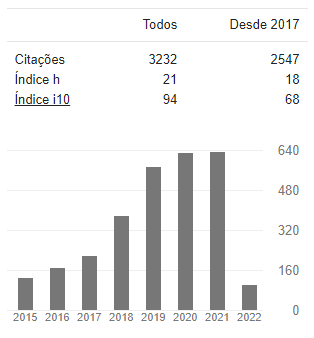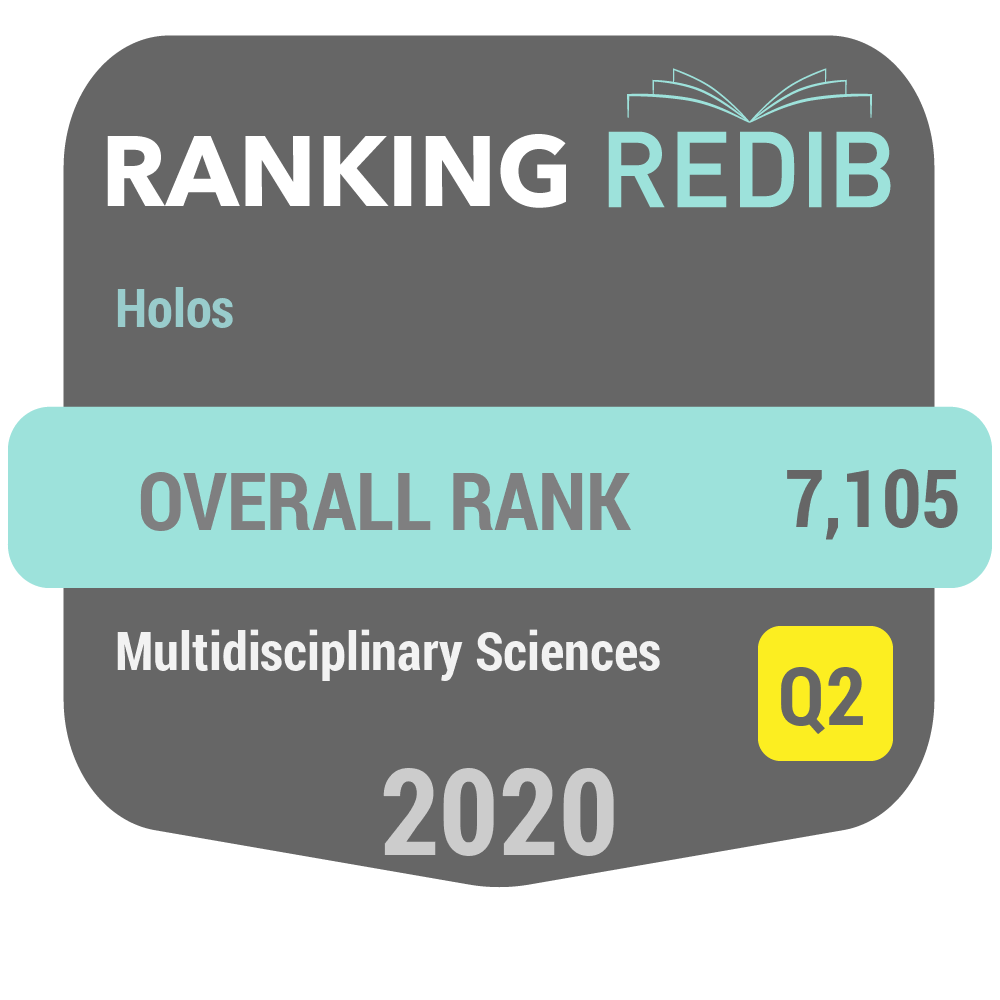AGRONOMIC FEASIBILITY OF GROWING CHIA IN NORTHWESTERN RIO GRANDE DO SUL
DOI:
https://doi.org/10.15628/holos.2018.6961Palavras-chave:
Spacing, sowing time, plant density, Salvia hispânica, crop rotationResumo
The aim of this work was to evaluate the development of Chia at different sowing times and plant spacings. The experiment was conducted in a commercial area located in the Northwest Region of RS in the municipality of Novo Machado. The experiment was conducted in a bifactorial arrangement with 2 spacings and 3 sowing times, with four replications. The factors analyzed were three different sowing times (January 15 and 30, and February 15) combined with two spacings (17 and 45 cm). The following parameters were evaluated: mean plant height, ear length, yield, weight of one thousand seeds, germination and first germination test count. The variable percentage of germination and its derivations were transformed into arcsin (X/100)1/2. The study showed that chia can be cultivated in the region, achieving good results for the parameters evaluated, mainly for grain yield. Sowing carried out in January and at the spacing of 17 cm between rows provided the best results.Downloads
Referências
Ayerza, R. (2009). The seed’s protein and oil content, fatty acid composition, and growing cycle length of a single genotype of chia (Salvia hispanica L.) as affected by environmental factors. Journal of Oleo Science, 58(7), 347-354. Available at https://www.jstage.jst.go.jp/article/jos/58/7/58_7_347/_pdf.
Ayerza, R.H.; Coates, W. (2007). Chía: Redescubriendoun olvidado alimento de los aztecas. Buenos Aires: Nuevo Extremo.
Ayerza, R.; Coates, W. (2011). Protein content, oil content and fatty acid profiles as potential criteria to determine the origin of commercially grown chia (Salvia hispanica L.). Industrial Crops and Products, 34(2), 1366-1371. Available at https://www.sciencedirect.com/science/article/pii/S0926669010003274. doi: 10.1016/j.indcrop.2010.12.007
Berlato, M. A.; Althaus, D. (2010). Tendência observada da temperatura mínima e do número de dias de geada do Estado do Rio Grande do Sul. Pesquisa Agropecuária Gaúcha, 16(1), 7-16. Available at http://www.fepagro.rs.gov.br/upload/1398780904_art01.pdf.
Brasil. (2009). Regras para análise de sementes. Brasília: Ministério da Agricultura, Pecuária e Abastecimento.
Bueno, M.; Di Sapio, O.; Barolo, M.; Busilacchi, H.; Quiroga, M.; Severin, C. (2010). Analisis de la calidad de los frutos de Salvia hispanica L. (Lamiaceae) comercializados em la ciudad de Rosário (Santa Fe, Argentina). Boletin Latino americano y del Caribe de Plantas Medicinales y Aromaticas, 9(3), 221–227. Available at http://www.redalyc.org/articulo.oa?id=85615232010
Busilacchi, H.; Quiroga, M.; Bueno, M.; Di Sapio, O.; Flores, V.; Severin, C. (2013). Evaluacion de Salvia hispanica L. cultivada en el sur de Santa Fe (República Argentina). Cultivos Tropicales, 34(4), 55–59. Available at http://scielo.sld.cu/pdf/ctr/v34n4/ctr09413.pdf
Coelho, M.S.; Salas-Mellado, M.M. (2014). Chemical Characterization of chia (Salvia hispanica L.) for use in food products. Journal of Food and Nutrition Research, 2(5), 263-269. Available at http://pubs.sciepub.com/jfnr/2/5/9/. doi: 10.12691/jfnr-2-5-9
Ixtaina, V.Y.; Nolasco, S.M.; Tomás, M.C. (2008). Physical properties of chia (Salvia hispanica L.) seeds. Industrial Crops and Products, 28(3):286–293. Available at http://www.academia.edu/2384320/Physical_properties_of_chia_Salvia_hispanica_L._seeds. doi: 10.1016/j.indcrop.2008.03.009
Ixtaina, V.Y.; Vega, A.; Nolasco, S.M.; Tomás, M.C.; Gimeno, M.; Bárzana, E.; Tecante, A. (2010). Supercritical carbon dioxide extraction of oil from Mexican chia seed (Salvia hispanica L.): Characterization and process optimization. The Journal of Supercritical Fluids, 55(1), 192–199. Available at https://www.sciencedirect.com/science/article/pii/S0896844610002135. doi: 10.1016/j.supflu.2010.06.003
Jamboonsri, W.; Phillips, T.D.; Geneve, R.L.; Cahill, J.P.; Hildebrand, D.F. (2012). Extending the range of an ancient crop, Salvia hispânica L. – a new ?3 source. Genetic Resource and Crop Evolution, 59, 171-178. Available at http://citeseerx.ist.psu.edu/viewdoc/download?doi=10.1.1.472.4146&rep=rep1&type=pdf. doi: 10.1007/s10722-011-9673-x
Jiménez, P.; Masson, L.; Quitral.; (2013). Composición química de semillas de chía, linaza y rosa mosqueta y su aporte en ácidos grasos omega-3. Revista chilena de nutrição, 40(2), 155-160. Available at https://scielo.conicyt.cl/pdf/rchnut/v40n2/art10.pdf. doi: 10.4067/S0717-75182013000200010
Lobo, R.L.; Alcocer, M.G.; Fuentes, F.J.; Rodriguez, W.A.; Morandini, M.; Devani, M.R. (2011). Desarrollo del cultivo de chía en Tucumán, República Argentina. Avance Agroindustrial, 32(4), 27-30. Available at http://www.eeaoc.org.ar/upload/publicaciones/archivos/45/20120302170735000000.pdf.
Luz, F.N.; Yamashita, O.M.; Ferraresi, D.A.; Carvalho, M.A.C.; Campos, O.R.; Koga, O.S.; Massaroto, J.A. (2014). Interferência de luz, temperatura, profundidade de semeadura e palhada na germinação e emergência de Murdannia nudiflora. Comunicata Scientiae, 5(1), 26-33. Available at https://dialnet.unirioja.es/servlet/articulo?codigo=5022032.
Koppen., W.P. (1948). Climatologia: com un estúdio de los climas de la tierra. México DF: Fondo de Cultura Econômica.
Migliavacca, R.A.; Silva, T.R.B; Vasconcelos, A.L.S.; Mourão Filho, W.; Baptistella, J.L.C. (2014). O cultivo da chia no Brasil: futuro e perspectivas. Journal of Agronomic Sciences, 3(1), 161-179. Available at http://www.dca.uem.br/V3NE/13.pdf.
Peiretti, P.G.; Meineri, G. (2008). Effects on growth performance, carcass characteristics, and the fat and meat fatty acid profile of rabbits fed diets with chia (Salvia hispanica L.) seed supplements. Meat Science, 80(4), 1116-1121. Available at https://www.sciencedirect.com/science/article/abs/pii/S0309174008001472. doi: 10.1016/j.meatsci.2008.05.003
Reyes-Caudillo, E.; Tecante, A.; Valdivia-López, M.A. (2008). Dietary fibre contente and antioxidant activity of phenolic compounds present in Mexican chia (Salvia hispanica L.) seeds. Food Chemistry, 107:656–663. Available at https://www.sciencedirect.com/science/article/pii/S0308814607008709. doi: 10.1016/j.foodchem.2007.08.062
Rovati, A.; Escobar, E.; Prado, C. (2012). Particularidades de la semilla de chía (Salvia hispanica L.). Avance Agroindustrial, 33(3), 39-43. Available at http://www.eeaoc.org.ar/upload/publicaciones/archivos/269/20121114121551000000.pdf.
Sá, D.A.C.; Santos, G.R.; Furtado, G.Q.; Erasmo, E.A.L.; Nascimento, I.R. (2011). Transporte, patogenicidade e transmissibilidade de fungos associados às sementes de pinhão manso. Revista Brasileira de Sementes, 33(4), 663–670. Available at http://www.scielo.br/pdf/rbs/v33n4/08.pdf. doi: 10.1590/S0101-31222011000400008
Santos, H.G.; Jacomine, P.K.T.; Anjos, L.H.C.; Oliveira, V.A.; Oliveira, J.B.; Coelho, M.R.; Lumbreras, J.F.; Cunha, T.J.F. (2006). Sistema brasileiro de classificação de solos. (2a ed). Rio de Janeiro: Embrapa Solos.
Soil Survey Staff. (2010). Keys to Soil Taxonomy. (11a ed). Washington: Natural Resources Conservation Service.
Stefanello, R.; Neves, L.A.S.; Abbad, M.A.B.; Viana, B.B. (2015). Germinação e vigor de sementes de chia (Salvia hispanica L. - Lamiaceae) sob diferentes temperaturas e condições de luz. Revista Brasileira de Plantas Medicinais, 17:1182-1186. Available at http://www.scielo.br/pdf/rbpm/v17n4s3/1516-0572-rbpm-17-4-s3-1182.pdf. doi: 10.1590/1983-084x/15_043
Zavalia, R.L.; Alcocer, M.G.; Fuentes, F.J.; Rodriguez, W.A.; Morandini, M.; Devani, M.R. (2011). Desarrollo del cultivo de chia em Tucumán, República Argentina. Revista Avance Agroindustrial, 32(4), 27-30. Available at http://www.eeaoc.org.ar/upload/publicaciones/archivos/45/20120302170735000000.pdf.
Wrege, M.S.; Oliveira, R.; João, P.L.; Herter, F.G.; Steinmertz, S.; Júnior, C.R.; Matzenauer, R.; Maluf, J.R.T.; Samarorone, R.; Pereira, I.S. (2004). Zoneamento agroclimático para a cultura do citrus no Rio Grande do Sul. Pelotas: Embrapa Clima Temperado.









































